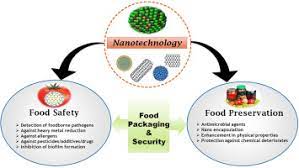
Nanotechnology is a newly emerging novel food packaging technique, which can increase the shelf life of foods, minimize the spoilage, ensure the food safety, repair the tears in packaging, reduce the problem of food shortage, and finally improve the health of the people. Food packages embedded with nanoparticles can alert the consumer about the safety of product. It can release preservatives to extend shelf life of food in package. Currently, food packaging and monitoring are a major focus of food industry related nanotechnology research. It is hoped that nanotechnology has a great potential in food industries as it may be used to manufacture about 25% of all food packaging in near future. It remains unclear whether nanoparticles used in food packaging may migrate or leach into the food. The potential impact of nanoparticles on consumer’s health should be well studied. Emphasis is given to assess the safety of ingredients in nanoparticles before their use in food products including packaging.
Nanotechonlogy is a newly emerging technique, which involves the characterization, fabrication, and manipulation of structures, devices or materials that have at least one dimension having 1-100 nm in length. This technology deals with nanomaterials and nanosystems commonly smaller than 100 nanometers. Nanomaterials are defined as materials with any external dimension on the nanoscale, and are clustered into three classes, namely nanoparticles, nanofibers and nanoplates. Nanocomposites are mixture of polymers of inorganic and inorganic additives having certain geometrics. Nanotechnology has diverse application areas such as nanoelectronics, packaging, biomedical, textile, sensor for security system, cosmetics, paints, medical and health care, paper manufacture, construction material, lubricants, weapons and explosives, batteries, agrochemicals, veterinary medicine, and water treatment. Presently, over 400 companies in the world are developing nanotechnology for its application in food and food packaging. Nanotechnology application in food industries can be utilized to detect bacteria in packaging, or produce stronger flavor, color quality, and safety for increasing the barrier properties. Precautions are needed to apply nanotechnology in food as very little knowledge is available on its impact on environmental and human health.
Application of Nanotechnology in Food Packaging
Nanotechnology is the science of very small materials that has a big impact in food industry including packaging. A variety of nanomaterials such as silver nanoparticle, titanium nitride nanoparticle, and nano-titanium dioxide, nano-zince oxide, and nanoclay are introduced as functional additives to food packaging. Nanotechnology enabled food packaging can be divided into three main categories.
Improved packaging: Nanoparticles are mixed with polymer chain to improve the gas barrier properties, as well as, temperature, humidity resistance of packaging. The use of nanocomposite in contact with food is approved by United States Food and Drug Adminstration.
Active packaging: The use of nanomaterials is helpful to interact directly with food or environment to allow better protection of the product. Several nanomaterils like nanocopper oxide, nanosilver, nanotitanium dioxide, nanomagnesium oxide and carbon nanotubes can provide antimicrobial properties. Presently, the use of silver nanoparticles as antibacterial agents in food packaging is increasing.
Intelligent/smart packaging: It is designed for sensing biochemical or microbial changes in the food. It can detect specific pathogen developing in the food or specific gases from food spoiling. Some smart packaging has been developed to use as tracing device for food safety. Currently, Nestle, British Airways and MonoPrix Super market are using chemical sensors, which can easily detect color change.
Biodegradable plastics are polymers, which can be divided into three categories according to source .
1. Polymers, which are directly extracted or removed from biomass include polysaccharides, proteins, polypeptides, polynucleotides.
2. Polymers such as biopolyester, polyacetic acid are produced by classical chemical synthesis using renewable biobased monomers or mixed source of biomass and petroleum.
3. Polymers are produced my microbes or genetically modified bacteria. The examples are bacterial cellulose, curdian, xanthan, pullan and polyhydroybutyrate.
Nanotechnology and Food Safety
Food safety is a growing public health concern of global significance. Foodborne microbial diseases account for about 20 million cases annually in the world. The primary objective of food safety is to assure that food will not cause any harm to the consumer when it is prepared and/eaten. It is important that all foods must be protected from physical, chemical, and biological contamination through processing, handling and distribution. Nanotechnology has brought revolution in food industry as it has several application in all areas of food science, from agriculture to food processing to security to packaging to nutrition and neutraceuticals . It extends the shelf life, enhances food safety and reduces packaging waste . It keeps the food fresh and flavor is maintained.
Packaging is enclosing the food material in a container to ensure the delivery of product in best condition to the consumer for final use. Therefore, good packaging plays a vital role in developing the image and brand of company product. Packaging protects the food and allows it to reach the consumer in hygienic and safe condition. The use of protective coatings and suitable packaging by food industry can certainly increase the shelf life of food products. Intelligent food packaging incorporating nanosensors can provide information on the state of the food inside. It is recommended that nanopackaging should be designed in such a way to release antimicrobials, antioxidants, flavors, enzymes and nutraceuticals to extend the shelf life of the food products. There is need to undertake further toxicological and migration studies in order to ensure safe development of nanotechnologies in the food packaging industry.







